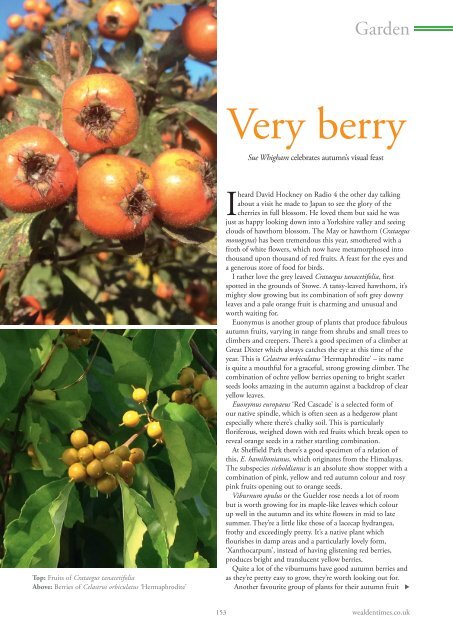Wealden Times | WT177 | November 2016 | Christmas Gifts supplement inside
Wealden Times - The lifestyle magazine for the Weald
Wealden Times - The lifestyle magazine for the Weald
You also want an ePaper? Increase the reach of your titles
YUMPU automatically turns print PDFs into web optimized ePapers that Google loves.
Garden<br />
Very berry<br />
Sue Whigham celebrates autumn’s visual feast<br />
Top: Fruits of Crataegus tanacetifolia<br />
Above: Berries of Celastrus orbiculatus ‘Hermaphrodite’<br />
I<br />
heard David Hockney on Radio 4 the other day talking<br />
about a visit he made to Japan to see the glory of the<br />
cherries in full blossom. He loved them but said he was<br />
just as happy looking down into a Yorkshire valley and seeing<br />
clouds of hawthorn blossom. The May or hawthorn (Crataegus<br />
monogyna) has been tremendous this year, smothered with a<br />
froth of white flowers, which now have metamorphosed into<br />
thousand upon thousand of red fruits. A feast for the eyes and<br />
a generous store of food for birds.<br />
I rather love the grey leaved Crataegus tanacetifolia, first<br />
spotted in the grounds of Stowe. A tansy-leaved hawthorn, it’s<br />
mighty slow growing but its combination of soft grey downy<br />
leaves and a pale orange fruit is charming and unusual and<br />
worth waiting for.<br />
Euonymus is another group of plants that produce fabulous<br />
autumn fruits, varying in range from shrubs and small trees to<br />
climbers and creepers. There’s a good specimen of a climber at<br />
Great Dixter which always catches the eye at this time of the<br />
year. This is Celastrus orbiculatus ‘Hermaphrodite’ – its name<br />
is quite a mouthful for a graceful, strong growing climber. The<br />
combination of ochre yellow berries opening to bright scarlet<br />
seeds looks amazing in the autumn against a backdrop of clear<br />
yellow leaves.<br />
Euonymus europaeus ‘Red Cascade’ is a selected form of<br />
our native spindle, which is often seen as a hedgerow plant<br />
especially where there’s chalky soil. This is particularly<br />
floriferous, weighed down with red fruits which break open to<br />
reveal orange seeds in a rather startling combination.<br />
At Sheffield Park there’s a good specimen of a relation of<br />
this, E. hamiltonianus, which originates from the Himalayas.<br />
The subspecies sieboldianus is an absolute show stopper with a<br />
combination of pink, yellow and red autumn colour and rosy<br />
pink fruits opening out to orange seeds.<br />
Viburnum opulus or the Guelder rose needs a lot of room<br />
but is worth growing for its maple-like leaves which colour<br />
up well in the autumn and its white flowers in mid to late<br />
summer. They’re a little like those of a lacecap hydrangea,<br />
frothy and exceedingly pretty. It’s a native plant which<br />
flourishes in damp areas and a particularly lovely form,<br />
‘Xanthocarpum’, instead of having glistening red berries,<br />
produces bright and translucent yellow berries.<br />
Quite a lot of the viburnums have good autumn berries and<br />
as they’re pretty easy to grow, they’re worth looking out for.<br />
Another favourite group of plants for their autumn fruit <br />
153 wealdentimes.co.uk


















